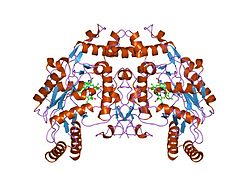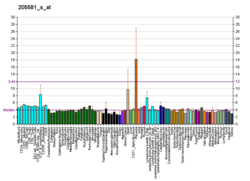
Back NOS3 Welsh Endotheliale Stickstoffmonoxid-Synthase German NOS3 French Siontáis intéiliach d'ocsaíd nítreach Irish Sintase nitrogen monoksida endotelial ID Ossido nitrico sintasi endoteliale Italian 内皮型一酸化窒素合成酵素 Japanese Эндотелиальная синтаза оксида азота Russian NOS3 Ukrainian
Endothelial NOS (eNOS), also known as nitric oxide synthase 3 (NOS3) or constitutive NOS (cNOS), is an enzyme that in humans is encoded by the NOS3 gene located in the 7q35-7q36 region of chromosome 7.[5] This enzyme is one of three isoforms that synthesize nitric oxide (NO), a small gaseous and lipophilic molecule that participates in several biological processes.[6][7] The other isoforms include neuronal nitric oxide synthase (nNOS), which is constitutively expressed in specific neurons of the brain[8] and inducible nitric oxide synthase (iNOS), whose expression is typically induced in inflammatory diseases.[9] eNOS is primarily responsible for the generation of NO in the vascular endothelium,[10] a monolayer of flat cells lining the interior surface of blood vessels, at the interface between circulating blood in the lumen and the remainder of the vessel wall.[11] NO produced by eNOS in the vascular endothelium plays crucial roles in regulating vascular tone, cellular proliferation, leukocyte adhesion, and platelet aggregation.[12] Therefore, a functional eNOS is essential for a healthy cardiovascular system.
- ^ a b c GRCh38: Ensembl release 89: ENSG00000164867 – Ensembl, May 2017
- ^ a b c GRCm38: Ensembl release 89: ENSMUSG00000028978 – Ensembl, May 2017
- ^ "Human PubMed Reference:". National Center for Biotechnology Information, U.S. National Library of Medicine.
- ^ "Mouse PubMed Reference:". National Center for Biotechnology Information, U.S. National Library of Medicine.
- ^ Marsden PA, Schappert KT, Chen HS, Flowers M, Sundell CL, Wilcox JN, Lamas S, Michel T (August 1992). "Molecular cloning and characterization of human endothelial nitric oxide synthase". FEBS Lett. 307 (3): 287–93. doi:10.1016/0014-5793(92)80697-F. PMID 1379542. S2CID 36429463.
- ^ Cockcroft JR (Dec 2005). "Exploring vascular benefits of endothelium-derived nitric oxide". American Journal of Hypertension. 18 (12 Pt 2): 177S–183S. doi:10.1016/j.amjhyper.2005.09.001. PMID 16373196.
- ^ Villanueva C, Giulivi C (Aug 2010). "Subcellular and cellular locations of nitric oxide synthase isoforms as determinants of health and disease". Free Radical Biology & Medicine. 49 (3): 307–16. doi:10.1016/j.freeradbiomed.2010.04.004. PMC 2900489. PMID 20388537.
- ^ Förstermann U, Sessa WC (Apr 2012). "Nitric oxide synthases: regulation and function". European Heart Journal. 33 (7): 829–37, 837a–837d. doi:10.1093/eurheartj/ehr304. PMC 3345541. PMID 21890489.
- ^ Oliveira-Paula GH, Lacchini R, Tanus-Santos JE (Feb 2014). "Inducible nitric oxide synthase as a possible target in hypertension". Current Drug Targets. 15 (2): 164–74. doi:10.2174/13894501113146660227. PMID 24102471.
- ^ Fish JE, Marsden PA (Jan 2006). "Endothelial nitric oxide synthase: insight into cell-specific gene regulation in the vascular endothelium". Cellular and Molecular Life Sciences. 63 (2): 144–62. doi:10.1007/s00018-005-5421-8. PMC 11136399. PMID 16416260. S2CID 22111996.
- ^ Sumpio BE, Riley JT, Dardik A (Dec 2002). "Cells in focus: endothelial cell". The International Journal of Biochemistry & Cell Biology. 34 (12): 1508–12. doi:10.1016/s1357-2725(02)00075-4. PMID 12379270.
- ^ Förstermann U, Münzel T (Apr 2006). "Endothelial nitric oxide synthase in vascular disease: from marvel to menace". Circulation. 113 (13): 1708–14. doi:10.1161/CIRCULATIONAHA.105.602532. PMID 16585403.
© MMXXIII Rich X Search. We shall prevail. All rights reserved. Rich X Search





